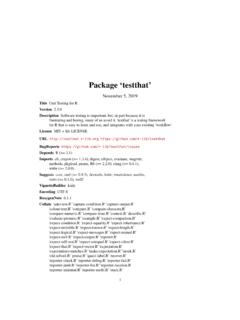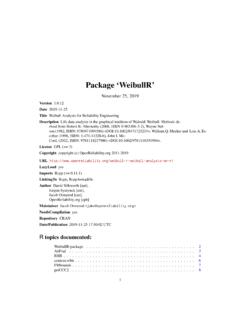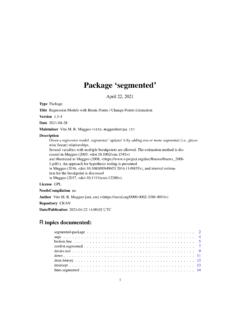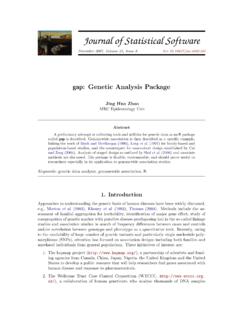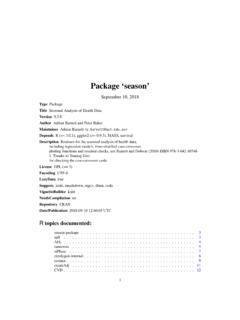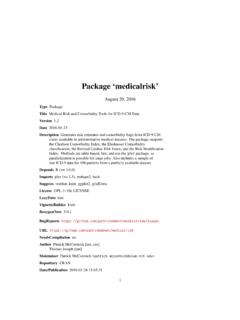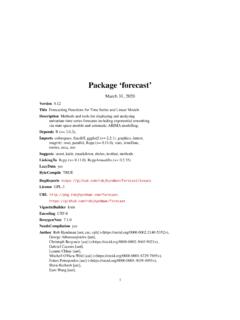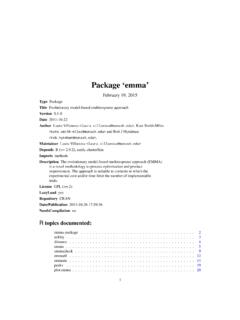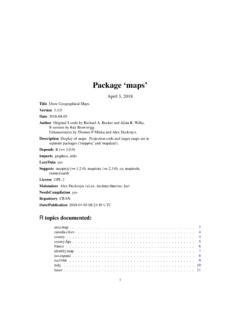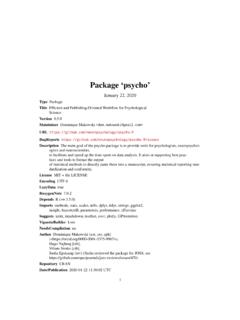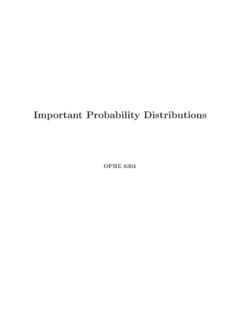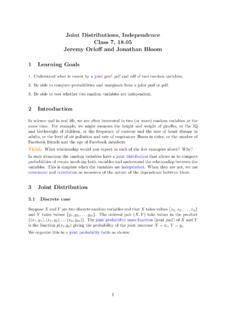Transcription of Fitting distributions with R
1 Fitting distributions with R 1 Fitting distributions WITH R Release February 2005 Vito Ricci Permission is granted to copy, distribute and/or modify this document under the terms of the GNU Free Documentation License, Version or any later version published by the Free Software Foundation: #FDL Copyright 2005 Vito Ricci Fitting distributions with R 2 TABLE OF CONTENTS Introduction Graphics Model choice Parameters estimate Measures of goodness of fit Goodness of fit tests Normality tests Appendix: List of R statements useful for distributions Fitting References Fitting distributions with R 3 Introduction Fitting distributions consists in finding a mathematical function which represents in a good way a statistical variable.
2 A statistician often is facing with this problem: he has some observations of a quantitative character x1, x2,.. xn and he wishes to test if those observations, being a sample of an unknown population, belong from a population with a pdf (probability density function) f(x,qqqq), where qqqq is a vector of parameters to estimate with available data. We can identify 4 steps in Fitting distributions : 1) Model/function choice: hypothesize families of distributions ; 2) Estimate parameters; 3) Evaluate quality of fit; 4) Goodness of fit statistical tests. This paper aims to face Fitting distributions dealing shortly with theoretical issues and practical ones using the statistical environment and language R1. R is a language and an environment for statistical computing and graphics flexible and powerful. We are going to use some R statements concerning graphical techniques ( ), model/function choice ( ), parameters estimate ( ), measures of goodness of fit ( ) and most common goodness of fit tests ( ).
3 To understand this work a basic knowledge of R is needed. We suggest a reading of An introduction to R 2. R statements, if not specified, are included in stats package. Graphics Exploratory data analysis can be the first step, getting descriptive statistics (mean, standard deviation, skewness, kurtosis, etc.) and using graphical techniques (histograms, density estimate, ECDF) which can suggest the kind of pdf to use to fit the model. We can obtain samples from some pdf (such as gaussian, Poisson, Weibull, gamma, etc.) using R statements and after we draw a histogram of these data. Suppose we have a sample of size n=100 belonging from a normal population N(10,2) with mean=10 and standard deviation=2: <-rnorm(n=200,m=10,sd=2) We can get a histogram using hist()statement (Fig. 1): hist( ,main="Histogram of observed data") 1 R Development Core Team (2004). R: A language and environment for statistical computing.
4 R Foundation for Statistical Computing, Vienna, Austria. ISBN 3-900051-07-0, URL: 2 R Development Core Team, An introdution to R, release , November 2004 Fitting distributions with R 4 [Fig. 1] Histograms can provide insights on skewness, behavior in the tails, presence of multi-modal behavior, and data outliers; histograms can be compared to the fundamental shapes associated with standard analytic distributions . We can estimate frequency density using density()and plot()to plot the graphic ( Fig. 2): plot(density( ),main="Density estimate of data") R allows to compute the empirical cumulative distribution function by ecdf() (Fig. 3): plot(ecdf( ),main= Empirical cumulative distribution function ) A Quantile-Quantile (Q-Q) plot3 is a scatter plot comparing the fitted and empirical distributions in terms of the dimensional values of the variable ( , empirical quantiles). It is a graphical technique for determining if a data set come from a known population.
5 In this plot on the y-axis we have empirical quantiles4 e on the x-axis we have the ones got by the theorical model. R offers to statements: qqnorm(), to test the goodness of fit of a gaussian distribution , or qqplot() for any kind of distribution . In our example we have (Fig. 4): <-( ( ))/sd( ) ## standardized data qqnorm( ) ## drawing the QQplot abline(0,1) ## drawing a 45-degree reference line 3 See [2005-01-11] 4 By a quantile, we mean the fraction (or percent) of points below the given value. That is, the (or 30%) quantile is the point at which 30% percent of the data fall below and 70% fall above that value. Fitting distributions with R 5 [Fig. 2] [Fig. 3] Fitting distributions with R 6 [Fig. 4] A 45-degree reference line is also plotted. If the empirical data come from the population with the choosen distribution , the points should fall approximately along this reference line.
6 The greater the departure from this reference line, the greater the evidence for the conclusion that the data set have come from a population with a different distribution . If data differ from a normal distribution ( data belonging from a Weibull pdf) we can use qqplot()in this way (Fig. 5): <-rweibull(n=200,shape= ,scale= ) ## sampling from a Weibull distribution with parameters shape= and scale= <-rweibull(n=200,shape=2, scale=1) ## theorical quantiles from a Weibull population with known paramters shape=2 e scale=1 qqplot( , ,main="QQ-plot distr. Weibull") ## QQ-plot abline(0,1) ## a 45-degree reference line is plotted Fitting distributions with R 7 [Fig. 5] where is the vector of empirical data, while are quantiles from theorical model. Model choice The first step in Fitting distributions consists in choosing the mathematical model or function to represent data in the better way.
7 Sometimes the type of model or function can be argued by some hypothesis concerning the nature of data, often histograms and other graphical techniques can help in this step (see ), but graphics could be quite subjective, so there are methods based on analytical expressions such us the Pearson s K criterion. Solving a particular differential equation we can obtain several families of function able to represent quite all empirical distributions . Those curves depend only by mean, variability, skewness and kurtosis. Standardizing data, the type of curve depends only by skewness and kurtosis5 measures as shown in this formula: )32)(1234(4)6(2122122221gggggg-+-+=K where: 3131)(smgnxnii =-= is Pearson's skewness coefficient [2005-02-04] Fitting distributions with R 8 3)(4142--= =smgnxnii is Pearson's kurtosis coefficient. According to the value of K, obtained by available data, we have a particular kind of function.
8 Here are some examples of continuous and discrete distributions6, they will be used afterwards in this paper. For each distribution there is the graphic shape and R statements to get graphics. Dealing with discrete data we can refer to Poisson s distribution7 (Fig. 6) with probability mass function: !),(xexfxlll-= where x=0,1,2,.. <-rpois(n=200,lambda= ) hist( ,main="Poisson distribution ") As concern continuous data we have: normal (gaussian) distribution8 (Fig. 7): 22)(2121),,(smspsm--=xexfwith Rx curve(dnorm(x,m=10,sd=2),from=0,to=20,ma in="Normal distribution ") gamma distribution9 (Fig. 8): xexxflaaalla--G=1)(),,( with+ Rx curve(dgamma(x, scale= , shape=2),from=0, to=15, main="Gamma distribution ") 6 See these websites for an overview on several kinds of distributions existing in statistical literature: ,, and [2005-01-11] 7 See: [2005-02-04] 8 See: [2005-01-12] 9 See: [2005-01-11] Fitting distributions with R 9 [Fig.]
9 6] [Fig. 7] Fitting distributions with R 10 [Fig. 8] Weibull distribution10 (Fig. 9): ])([1),,(abaaabbaxexxf---= with+ Rx curve(dweibull(x, scale= , shape= ),from=0, to=15, main="Weibull distribution ") To compute skewness and kurtosis index we can use those statements: skewness() and kurtosis() included in fBasics package (you need to download this package from CRAN website): library(fBasics) ## package loading skewness( ) ## skewness of a normal distribution [1] kurtosis( ) ## kurtosis of a normal distribution [1] skewness( ) ## skewness of a Weibull distribution [1] kurtosis( ) ## kurtosis of a Weibull distribution [1] 10 See: [2005-01-12] Fitting distributions with R 11 [Fig. 9] Parameters estimate After choosing a model that can mathematically represent our data we have to estimate parameters of such model. There are several estimate methods in statistical literature, but in this paper we are focusing on these ones: 1) analogic 2) moments 3) maximum likelihood Analogic method consists in estimating model parameters applying the same function to empirical data.
10 , we estimate the unknown mean of a normal population using the sample mean: <-mean( ) [1] The method of moments11 is a technique for constructing estimators of the parameters that is based on matching the sample moments with the corresponding distribution moments. This method equates sample moments to population (theorical) ones. When moment methods are available, they have the advantage of simplicity. We define sample (empirical) moments in this way: - t-th sample moment about 0: initityxm ==1 t=0,1, 11 See [2005-02-08] Fitting distributions with R 12 - t-th sample moment about mean: initityxm =-=1')(m t=0,1, while theorical (population) ones: - t-th population moment about 0: dx) ,(*xfxmtt =ab t=0,1, - t-th population moment about mean: dx) ,()('*xfxmtt -=abm t=0,1, where b-a is the range where f(x,qqqq) is defined, m is the mean of the distribution , and yi are emprirical relative frequencies.
